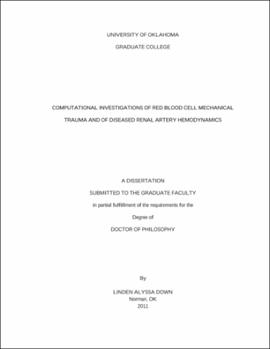| dc.contributor.advisor | O'Rear, Edgar||Papavassiliou, Dimitrios | |
| dc.creator | Down, Linden | |
| dc.date.accessioned | 2019-04-27T21:28:17Z | |
| dc.date.available | 2019-04-27T21:28:17Z | |
| dc.date.issued | 2011 | |
| dc.identifier | 99218357702042 | |
| dc.identifier.uri | https://hdl.handle.net/11244/318772 | |
| dc.description.abstract | In this work, Computational Fluid Dynamics (CFD) and Fluid Structure Interaction (FSI) methods were used to study two separate problems: red blood cell damage in flow and the hemodynamics of diseased renal arteries; specifically, those with renal artery stenoses or aneurysms. | |
| dc.description.abstract | The study of red blood cell trauma was motivated by deficiencies in the current empirical models used for hemolysis estimation. Using CFD, classic hemolysis experiments performed in capillary tubes for laminar flow and a Couette viscometer for turbulent flow were re-examined. The results of the capillary tube simulations indicated that the extensional stresses present in the flow contributed to hemolysis, with a threshold value of approximately 3000 Pa for exposure times on the order of microseconds being indicative of hemolysis. In the turbulent Couette viscometer simulations, where experimental exposure times were five minutes, it was found that Kolmogorov Length Scales of the same order of magnitude as the size of a red blood cell were indicative of hemolysis, with some dependence on the median Kolmogorov Length Scale in the flow. The results of an inter-laboratory FDA study are also reported. | |
| dc.description.abstract | Simulations of diseased renal arteries were also performed, which included simulations of stenoses and aneurysms of varying geometries. Initially, this work was done solely with CFD, however FSI was eventually incorporated into the renal artery aneurysm simulations. The results of this study indicate that the uncertain relationship between renal artery aneurysms and renin-dependent hypertension is possibly related to transient occlusions of the artery that occur when high pressure within the aneurysm causes the aneurysm and underlying vessel wall to deform into the blood stream | |
| dc.format.extent | 176 pages | |
| dc.format.medium | application.pdf | |
| dc.language | en_US | |
| dc.relation.requires | Adobe Acrobat Reader | |
| dc.subject | Blood flow | |
| dc.subject | Hemodynamics | |
| dc.subject | Renal artery--Diseases | |
| dc.title | COMPUTATIONAL INVESTIGATIONS OF RED BLOOD CELL MECHANICAL TRAUMA AND OF DISEASED RENAL ARTERY HEMODYNAMICS | |
| dc.type | text | |
| dc.type | document | |
| dc.thesis.degree | Ph.D. | |
| ou.group | College of Engineering::School of Chemical, Biological and Materials Engineering | |
